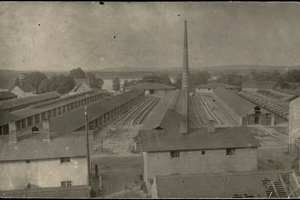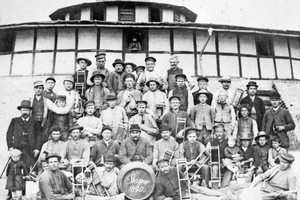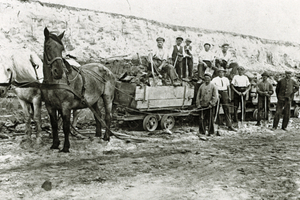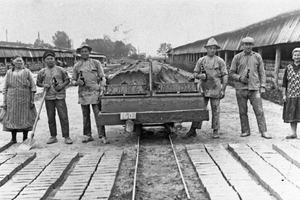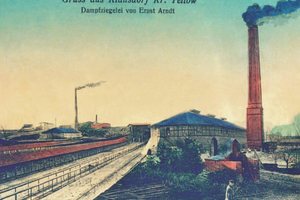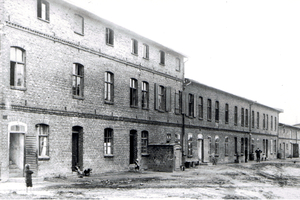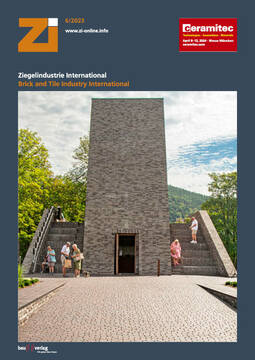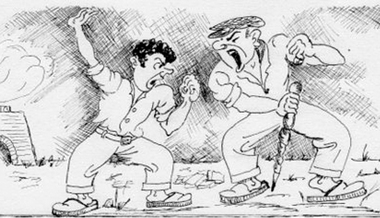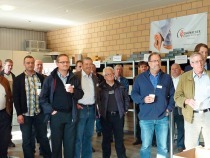Brickmakers from Lippe in the environs of Berlin around 1900
Today, too, there are still regions in Germany where there are not enough jobs to give their inhabitants a living wage. Although, unlike in the time that we are addressing in the following, social security may save people from utter destitution today, many people leave their homes to find work in other parts of the country or abroad. This situation is, however, by no means comparable with that in which a large number of inhabitants of the German principality of Lippe found themselves for a long time.
Back in the 17th century, forced by economic hardship, men from Lippe left their homes and farms from spring until autumn to earn money as grass and peat cutters in Holland and Friesland. With the onset of the crisis in the linen trade in the region in the 1830s, the Lippe men found another gap in the market: “work-shared brickmaking in fixed gangs at brickyards”[i]. This specialization opened up for them the job market over all of Germany and even abroad. Seasonal migratory labour in Lippe reached its peak around 1900.[ii]
At this time and over the last decades of the 19th century, the city of Berlin registered never- before-known growth in the wake of industrialization. To house the people flocking in their droves and the mushrooming industries, numerous residential and factory buildings were erected. The brickyards around Berlin hired seasonal workers – and they were happy to take on men from Lippe as the Lippe brickmakers were preceded by their good reputation.
In the following, we begin with an examination of the living conditions in Lippe in the second half of the 19th century to establish why its inhabitants had to turn their backs on their home in the first place. Then, we describe the situation in the city of Berlin, which became a destination for Lippe’s itinerant brickmakers probably from the 1860s at the latest.[iii] The living and working conditions form the core of our account, and finally we examine why the Lippe workers withdrew from Berlin and how things continued in the brickmaking trade in Berlin.
The situation in Lippe in the second half of the 19th century
In the second half of the 19th century, most inhabitants of Lippe earned their living in agriculture. Primogeniture prevailed, which meant that a farm was inherited undivided by the oldest son of a family. This meant that the majority of the population were landless and only able to work small areas as farm labourers. To safeguard their livelihood, these Lippe inhabitants had to earn their money in cottage industries and as migrant workers.[iv] The cottage industries, based on the “putting-out system”[v], mainly involved spinning and weaving linen yarn. The cloth itself, however, was finished outside of Lippe.[vi]
Several reasons led to the slump in this business at the beginning of the 19th century. One of these was the fierce competition from the linen industry in England, which thanks to mechanized production was able to supply low-priced goods to the world market. More problematic, however, was that Lippe was bypassed by industrialization. Here everything stayed as it had always been, while in surrounding regions, linen-making was moved into factories. Minden-Ravensberg had been given completely different opportunities thanks to its connection to the Cologne-Minden railway in 1846/48 to serve markets in other regions. Bielefeld and Herford in particular thrived economically. Lippe, however, did not have this connection and therefore no access to a bigger sales market.[vii] With the collapse of these avenues for earnings and in view of rising population figures, migrant work, which had already been common practice since the 17th century, became even more important.[viii]
A good source of income had been found by the Lippe inhabitants in brickmaking. On account of the rich clay deposits in their home region, they already had a lot of experience in this trade. The building boom as a result of industrialization made sure that their knowledge and skills were in demand in the entire country – including in Berlin and its environs, too. Thanks to this source of income, they were able to escape poverty and permanent migration.[ix] Many families saved every penny they got to be able to afford their own homestead with their income from itinerant brickmaking and subsistence farming. “Towards the end of the 19th century, in many Lippe villages, so-called ‘new homesteads’ were established. A strikingly large number of these small homesteads [with ‘Zieglerkotten’, i.e. ‘solid-built brick cottages’] were bought by brickmakers.”[x]
Berlin and the building boom
Like probably all cities in the “Reich” that enjoyed the economic upswing that accompanied industrialization, Berlin grew at an unprecedented pace. With the rate the factories shot up out of the ground, an increasing number of workers was needed. While the city reported 931 984 inhabitants in 1871, the population counted over one million people more by 1890. And just another ten years later, with 2 712 190 inhabitants, Berlin hovered just below the three-million mark, which it topped just a short time later.[xi] For these people, housing first had to be built.
The boom in Berlin also effected the industrialization of some regions of Brandenburg that had been mainly agrarian up until then.[xii] At many places close by, proper centres of the brickmaking industry grew up, producing almost exclusively for the Berlin market, to meet the city’s huge demand for clay bricks (» Fig. 1). The brick industry had always been dependent on close proximity to clay deposits, as well as short distances and convenient transport links to its sales market.[xiii] The bricks from the Brandenburg brickworks were transported on barges, the ‘Kaffenkähne, via Havel, Spree and the other offshoots in the network of waterways in the region around Berlin.[xiv]
That so many of Berlin’s new buildings were built of bricks was not least credit to the Prussian architect Karl Friedrich Schinkel. In the mid-1820s, he had “brought clay brick to the fore as a key design element” [xv], introducing a change in architectural style.[xvi] Facing bricks, however, were used principally for public or commercial buildings, while the Brandenburg backing bricks were used predominantly for erecting Berlin’s tenements.[xvii]
Key feature of Brandenburg’s brick industry were the above-mentioned centres around which the brickyards clustered. “The brickyards lying around Berlin are spread across ten districts, that is: Ketzin a. d. Havel, Werder a. d. Havel, Lehnin, Brandenburg a. d. Havel, Plaue a. d. Havel, Zehdenick, Herzfelde, Königswusterhausen, Clausdorf and Mittenwalde.”[xviii] Particularly striking was the concentration of brickyards in Zehdenick, Glindow and Rathenow.[xix] Fontane reports in 1870 about more than 50 annular kilns in the Glindow district.[xx] The Zehdenick region peaked in 1911 with 63 annular kilns at 34 brickworks. Here the production output in that year was 600 to 700 million bricks.[xxi] For 1905, there is a record of a total of 227 brickworks, which produced bricks with an annual output totalling over 1.7 billion bricks for the German capital. [xxii] Rathenow and Birkenwerder produced “the most famous bricks fired in these parts, [...] the ‘red Rathenow bricks’ and the ‘buff-coloured Birkenwerder bricks’.”[xxiii]
In the beginnings of the Brandenburg brick industry, the region did not have enough qualified workers; in many places, like, for example Zehdenick, there had been next to no traditional brickmaking. [xxiv] So the industry there was dependent on experienced brickmakers and often called on the itinerant brickmakers from Lippe.
The itinerant brickmakers and their road to distant workplaces
Lippe’s itinerant brickmakers came from the class of labourers and agrarian craftsmen, that is the class that could not survive without supplementing their earnings from agriculture. In spring, the men left their home, worked at brickyards in different parts of the country and then returned to their family and home turf in autumn. During their absence – providing the men were married, their wife and children looked after home and harvest.
Hiring
The Lippe men specialized in working in groups or gangs. As long distances lay between the place of work and the workers‘ homes, hiring was different than in brickworks in the local area. There were various ways for brickworks owners to find suitable workers if they did not already have contact with a master brickmaker. On the one hand, they could put an advertisement in relevant journals. On the other hand, they could contact an agent to procure them the necessary workers. Up to 1869, the privilege of working as a so-called ‘Ziegelbote’ or ‘brick messenger’ was awarded by the government. After that, anyone could run an agency to mediate between brickworks owners and brickmakers, in this case also a link between Berlin and Lippe.[xxv]
After the contact had been made, the brickyard master negotiated with the brickyard owner to agree a contract for a campaign – this was what they called the production period, which generally lasted from April to October. Once the agreement had been reached. the master brickmaker put together his gang. He generally tried to enlist friends and relations first. Otherwise, the inns and brickmakers’ markets, which were held on Wednesdays and Sundays in the winter months, provided an opportunity to find suitable men. Depending on the size of the brickworks, a brickmakers gang consisted of twenty to thirty workers (» Fig. 2). Often, they went for years with a master to the same brickworks. If they were in agreement, a handshake was enough to seal a mutual commitment. There was as good as never any contracts in writing.[xxvi]
The contract conditions
The brickworks owner gave over the entire operation of his brickworks to one master and his crew on a piecework basis. As, in around the year 1900, most brickworks made hand-moulded bricks, the campaign only ran over the time from April to October, that is over the frost-free months. The men worked through one season and were usually paid a previously agreed sum of money for one thousand fired bricks. So at a brickworks in Zehdenick around 1890, 4.20 German marks was reported as the price for one thousand finished bricks.[xxvii]
On his “Ramblings through the March of Brandenburg” (1862-1889), Theodor Fontane travelled through Glindow and reported:
“Foreign brickmakers have been used here for a long time. The native workers are just not enough. It used to be ‘men from Eichsfeld’ who came and worked a summer campaign here. But then eventually the ‘Eichsfeld men’ stopped turning up or were sacked, and the Lippe men came in their stead. They still hold the ground here now. The Lippe men, and only the men, come in April and stay to mid-October. [...]. At their head stands a master who is only in charge of direction and management. He makes the agreements, receives the monies and shares them out. The work is piecework, the firing material and the equipment are all supplied, the clay is brought to the aging pits, the kiln is made available to them. Everything else is their business. At the end of the campaign, for every thousand fired bricks, they get one and two thirds to two thalers. The total sum for eight to ten million bricks is customarily up to 15 000 thalers.”[xxviii]
The brickworks owner only had to provide the means of production and take care of the sale of the fired bricks. The Lippe workers, on the other hand, depended on good weather and good equipment. It was in their interest to produce as many bricks as possible to maximize profit from their campaign. Although the brickyard owner could not actually stop the workers from breaking their contract, he did not generally need to worry that the workers would leave the brickworks early. Unless it was peak season when better earnings prospects were offered to them elsewhere.[xxix]
“At the brickyard”
The Lippe brickmakers took the train to their ‘foreign’ workplaces. Long distances, that is, to the railway station and from there to the brickyards, they covered on foot. Having arrived at their destination, they moved into their brickmakers’ lodgings. They brought only very little with them from their homes. As a rule, they travelled with their bedding and a crate of food.
Board
Their food was home produce that had been preserved to keep a long time. It mainly consisted of smoked meat and pulses. After all, ‘at the brickyard’, the Lippe workers looked after themselves and these reserves guaranteed they could last out for many weeks without any additional costs or time.[xxx] Anything that went beyond that and when the stores had been used up, the master bought from local traders or had goods sent from home by mail order companies. In the so-called Commune book he noted down which workers had consumed what so that it could be deducted from the wage of each brickmaker what he had to pay for the food he had consumed.[xxxi]
The daily board was called “Kommunie”, a communal arrangement, and was organized for the brickmaker community. In the mornings, they got mostly only coffee, with some bread. The main meal was their midday meal, which the youngest workers were usually tasked to cook and generally consisted of stew. Their diet was not very varied, but met the enormous need for calories after their hard physical labour. In the evenings, they either finished off leftovers from the midday meal or everyone got their own food. The costs for the food eaten by the gang was deducted by an equal amount from everyone’s wages and often collected as a weekly fee.[xxxii]
The lodgings
As the brickyards were mostly located in the open countryside, well away from towns and villages, the itinerant brickmakers rarely lived among the locals. They moved into “brickmakers’ barracks” (» Fig. 3) that had been put up either at the edge or in the middle of the brickyard.[xxxiii] This meant they didn’t have far to walk to work. If the brickworks lay close to a village, then the workers found accommodation there, sometimes in boarding houses built especially for this purpose.[xxxiv]
The houses for the itinerant brickmakers that Fontane found in Glindow were “solid” and had “a kitchen on the ground floor, a refectory on the first floor, and a dormitory on the second floor”[xxxv]. In principle, such a set-up was probably common in other places, too. However, from many regions in Germany there are accounts that the accommodation was unfit for human habitation, that the workers had to sleep in draughty wooden huts, right next to the barns or the annular kiln.[xxxvi] On account of the work and accommodation, the brickmakers grew into a close-knit community. Good teamwork was exceptionally important as each worker’s earnings depended on the performance of his workmates. They did not spend much time in their accommodation. They wanted to make the most of the short campaign time, so they worked fourteen to sixteen hours a day. Work started at sunrise and ended when the sun went down.[xxxvii]
The work
Although some companies employed machines in their production, in Zehdenick up to the middle of the 20th century, brickworks making hand-moulded bricks prevailed. This was mainly to do with the nature of the local Havelland clay that could be worked well in this way but was not suitable for extruders. In the early years, there was enough cheap labour available for the hand-moulding method, and in this way the brickworks owners saved on the high costs for acquiring and running machines. For almost the same production costs, the sales price for hand-moulded bricks was only negligibly lower.[xxxviii]
At the beginning, the brickworks were set up for manual work in all areas. Every brickmaker had a certain job. First the clay in the clay pits was dug by the clay diggers with a spade and shovelled onto trollies (» Fig. 4), drawn by horses to the mixing benches. These were pits in which the clay was mixed with water and, if required, sand, before being worked to a homogeneous body. Again, horses drew a barrow weighted with rocks in a circle through the clay and rolled it thoroughly.
Once the clay was ready for the next stage of working, it was taken by the barrow boys to the moulding tables (» Fig. 5). The brickmakers threw the clay into the wooden moulds. These were generally double moulds so that one brick-moulder could produce two bricks in each work cycle – in one day, he was able to make up to 200 bricks, which the off-bearers then, with the help of the brick moulding frame, lay on the ground beside the table to dry. At big brickyards, these tables were mounted on rails so that they could be moved and advanced as the pile of bricks made grew. After two to three days, the moulded bricks were dry enough for them to be turned over onto their narrow side so that their underside could dry before they were moved to the drying racks. On these racks, they were protected against the elements and dried for at least another two weeks.
At the end of the drying period, the kiln gang loaded the moulded bricks into the annular kiln (» Fig. 6). A worker known as a ‘Zuschieber’ (‘pusher’) delivered the bricks while the setters stacked them in a certain pattern in the firing chamber. The kiln was fired by the burner who threw coal from the roof of the kiln through stokeholes. Because the kiln was built such that the fire moved through the different chambers in a circle, it was possible to fire the kiln around the clock over the entire season. So just a few metres away from the setters, the unloaders laboured to empty fired and already cooled bricks from the firing chambers. Nevertheless, temperatures still reached 40 to 50 °C in the cooled chambers. The kiln gang had to cope with constantly changing temperatures. Each day, two chambers were emptied and then reloaded.[xxxix]
In response to the fiercely growing competition and the overproduction of bricks towards the end of the 19th century, some brickyards deviated from the purely manual production as described above and introduced some technical innovations. The horse-driven mixing table was replaced with clay separating machines: two head-high rollers driven by a steam engine. At the beginning of the 20th century, the workers who had cut the clay with a spade were replaced with diggers. In the course of these changes, machinists were taken on as additional workers.[xl]
Transport
The finished bricks were transported direct to the building sites in Berlin. This was done, as described above, usually via the network of waterways. Up to 1918 rail transport only accounted for a small part. The bigger brickworks, some of which with up to 30 hectares of land, had their own harbour for this purpose.[xli] The bricks themselves were transported by locally based boatmen with whom the brickworks owners had agreed contracts. The bricks were taken to the harbour on wheelbarrows, which were pushed over narrow planks for loading directly on the barge. Around 100 bricks fitted on one barrow.[xlii] The barges that were typical for the region did not have a great deal of depth and were either towed, sailed or poled.[xliii] They held up to 70 000 masonry bricks and travelled on the different riverways and canals close to the building sites. Once they had arrived there, they were loaded by hand onto wheelbarrows or taken to the building sites on carts pulled by horses.[xliv]
The Lippe brickmakers and the locals
The long working days did not leave the Lippe brickmakers much time for leisure. In the evenings they sat together or wrote letters to their family. Only Sundays gave them any opportunity to do anything and mix with the local population. On Sundays, there were balls and dances. On 11 September 1909, the newspaper Der Zehdenicker Anzeiger printed an invitation to the “Brickmakers’ Leaving Ball“. In the brickmaking trade, the Lippe brickmakers were preceded by their good reputation. They were regarded as able, hard-working and modest and – as they were Protestant – they did not claim as many religious holidays in the year as workers from Catholic regions. They were held in high esteem for their punctuality, reliability and sobriety.[xlv]
We cannot say anything with any certainty about how the itinerant brickmakers were perceived by the locals. Benke assumes for the Zehdenick region that they were not seen as a danger or “alien” as the importance of the brick industry in this region was so high and any workers settling there was regarded more as an opportunity.[xlvi]
The end of Lippe brickmaking in Berlin
The brick trade functioned largely as a seasonal operation. However, some workers were employed in winter. On the one hand, the equipment that had been in such heavy use in the summer months had to be repaired and maintained. On the other hand, at many brickyards, moulded and stored bricks were fired. This was done by the local workers. In winter, the building trade, on which the brick industry was dependent, was also wound down. In fact, its sales hinged on the demand for bricks at Berlin’s building sites. This market was hit by several crises. Between 1870 and 1914, despite many minor crises, steady growth was possible, but some sites that had not modernized their production in good time or those with dwindling reserves of clay encountered problems and registered sales losses. The situation became more serious with the collapse of the building market in 1913, sparked by the looming threat of war and generally poorer economic conditions, and ultimately with the halt of construction following the outbreak of the First World War. As a consequence, many brickworks in the region were mothballed, and some of these did not resume production in the post-war period. Only with the Weimar Republic did the situation in the construction and construction materials market stabilize again. However, the next collapse followed soon after in 1930 with the world economic crisis.[xlvii] By that time, the numbers of itinerant brickmakers from Lippe in Berlin’s environs had declined. Their number was already falling by around 1895 because more money could then be made in the west of Germany.[xlviii]
Without Lippe brickmakers, no Berlin
What the itinerant brickmakers from Lippe brought to the area around Berlin was their good reputation, their know-how and their specialization in making bricks in gangs organized according to the specific areas of work. In the second half of the 19th century, the emerging, rapidly growing Berlin needed enormous quantities of bricks, which were supplied by the brickyards springing up in the city’s hinterland. At the beginning, the brickworks owners had neither enough experience nor sufficiently qualified workers, so that the seasonal workers from Lippe came along just at the right time. As a gang, they took over the entire production process – from digging clay to the finished fired bricks. They worked tirelessly from spring to autumn – leaving them hardly any time to mix with the locals, before they returned to their homes in mid-October. Presumably, apart from technical knowhow, there was hardly any cultural exchange. There was too little time for that, and their isolated way of living did not afford them many opportunities. Not even when it came to eating did they deviate from their habits, if you think about the fact that they brought their own food or even had it sent from their homeland.
Shaken by crises, the building trade collapsed at the beginning of the 20th century and made only a poor recovery. Even if the number of itinerant brickmakers from Lippe in the Berlin region had long been on the decline by that time, in the years of the strongest growth, they played a key role in the rise of Berlin to a metropolitan city.

